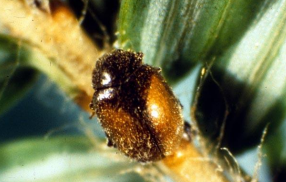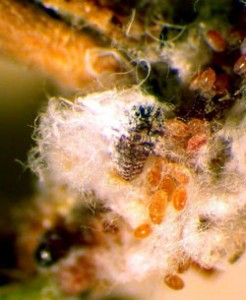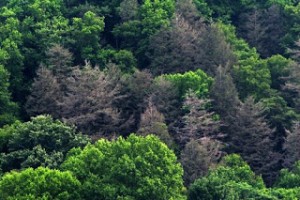The dark but delicate beauty of hemlocks has inspired various poems and songs for centuries. Feathery, lacy and graceful, these trees are gorgeous additions to the landscape. No wonder that the hauntingly beautiful hemlock is referred to as the queen of conifers! Sadly, the giant hemlocks are under attack by an invasive  insect barely visible to the eye but potent enough to completely wipe out these evergreens. For nearly 60 years or so, the woolly adelgid, which originated in Japan, has been killing our beloved hemlocks. It is called a woolly adelgid because it is covered with a “woolly”, or fluffy white waxy covering for most of its life. This adelgid primarily sucks the sap out of the tree and deprives the tree of nutrients and sugar for energy. This defoliation could result in the death of a hemlock in around 3-6 years!
insect barely visible to the eye but potent enough to completely wipe out these evergreens. For nearly 60 years or so, the woolly adelgid, which originated in Japan, has been killing our beloved hemlocks. It is called a woolly adelgid because it is covered with a “woolly”, or fluffy white waxy covering for most of its life. This adelgid primarily sucks the sap out of the tree and deprives the tree of nutrients and sugar for energy. This defoliation could result in the death of a hemlock in around 3-6 years!
The Hemlock woolly adelgid first arrived in the U.S. Pacific Northwest via nursery plants from Japan in 1924. Since then the insect has spread to more than 15 US states! These crawlers feed on the new growth of hemlocks by piercing the twigs that hold the branches, sucking the sap, and injecting toxic  saliva. The needles turn from a deep green to a grayish green and eventually die, depriving the tree of nutrition of photosynthesis. Infection is signaled by either a white, cotton-like material that appears along with a tree’s twigs or by the ‘baldness’ of a tree’s upper branches. The hemlock woolly adelgid has enjoyed remarkable success in destroying trees because of its impressive reproductive potential: consider that one female in the winter generation produces an average of 200 eggs which in turn mature and each female of this generation produces on average another 200 eggs each. That’s 40,000 eggs in one year, starting from one individual female!
saliva. The needles turn from a deep green to a grayish green and eventually die, depriving the tree of nutrition of photosynthesis. Infection is signaled by either a white, cotton-like material that appears along with a tree’s twigs or by the ‘baldness’ of a tree’s upper branches. The hemlock woolly adelgid has enjoyed remarkable success in destroying trees because of its impressive reproductive potential: consider that one female in the winter generation produces an average of 200 eggs which in turn mature and each female of this generation produces on average another 200 eggs each. That’s 40,000 eggs in one year, starting from one individual female!
 Because large woodland tracts of hemlocks are being decimated, the environment is being impacted negatively in several ways. Resultant erosion and heating up of streams destroy fish, other wildlife, and watersheds. In Michigan, hemlocks had decreased by almost 70% in the short 20-year span between 1935 and 1955. Hemlock forests, which covered about 41% of the land area of the Bruce Peninsula, are almost non-existent today. Currently, more than 5000 acres of hemlocks across 119,000 acres in the southern tip of York County are considered infested with scattered, low-level adelgid populations. These insects have killed almost 90% of hemlock trees in Shenandoah National Park, Virginia. To mitigate the impact of the adelgid, the United States Forest Service has funded around $4.5 million per year in recent years!
Because large woodland tracts of hemlocks are being decimated, the environment is being impacted negatively in several ways. Resultant erosion and heating up of streams destroy fish, other wildlife, and watersheds. In Michigan, hemlocks had decreased by almost 70% in the short 20-year span between 1935 and 1955. Hemlock forests, which covered about 41% of the land area of the Bruce Peninsula, are almost non-existent today. Currently, more than 5000 acres of hemlocks across 119,000 acres in the southern tip of York County are considered infested with scattered, low-level adelgid populations. These insects have killed almost 90% of hemlock trees in Shenandoah National Park, Virginia. To mitigate the impact of the adelgid, the United States Forest Service has funded around $4.5 million per year in recent years!
The severity of this issue can be better understood by reading the following article;
Hemlock Woolly Adelgid in Skaneateles Lake Watershed
Posted on: June 23, 2014
Published by: Kristina Ferrare
The invasive insect, Hemlock Woolly Adelgid (Adelges tsugae) also known as HWA has recently been confirmed on hemlock trees in the Bahar Nature Reserve along the western shore of Skaneateles Lake in the Town of Niles, and recently confirmed by the NYS DEC along the eastern shore in the Town of Spafford. HWA was first confirmed in Cayuga County in 2012, and has significantly expanded its range into the Owasco Lake Watershed and into Fillmore Glen State Park.
HWA is a tiny aphid-like insect that feeds on twigs at the base of hemlock needles. The damage prevents the transport of nutrients to the needles and buds, effectively starving the tree. Tree death commonly occurs six or more years after infestation in the Finger Lakes region, but may cause death within 4 years in warmer states. HWA gets its name from the white waxy hairs that protects the insect while it feeds in the winter, appearing like masses of white wool along the stems of hemlock branches.
Hemlock trees are known as keystone species – other species of plants and wildlife depend on hemlock trees as a food source, shelter, and insulation during summer and winter months. Without hemlock, the remaining ecological community also becomes threatened. Hemlock is found in the deep coves and steep slopes characteristic of the southern end of Skaneateles Lake and much of the Finger Lakes region.
HWA has been in eastern US for well over 60 years, but didn’t get a foothold in NY until it was found in the lower Hudson Valley in the mid 1980’s. It has rapidly spread in recent years, likely aided by mild temperatures. Recent cold weather has helped to slow the spread of HWA, but because it reproduces quickly, will have only a short term impact. Highly effective pesticide treatments are available, and research into biological controls in the Finger Lakes region is continuing.
Skaneateles Lake is the drinking water for the City of Syracuse and the widespread loss of hemlock has ecological consequences that can trigger loss of water quality in the lake. Treating hemlock trees for HWA should be done with caution in order to prevent unnecessary pesticide contamination into the Lake.
 Evidently, unless proper measures are taken, hemlock, which is one of the most common trees in the US, may soon drop off the list, going the way of the now-vanished chestnut and elm due to the hemlock woolly adelgid. Infested hemlock trees can be protected individually with chemicals and insecticides. However, the costs associated with application, environmental safety concerns about applying toxic insecticides, and the tremendous reproductive potential of the adelgid makes this approach less feasible on a broad scale in natural areas. Also, it is obvious that simply removing and destroying infested stock, which proved so successful when dealing with individual infested trees, is not a feasible long term solution for addressing a large population of trees.
Evidently, unless proper measures are taken, hemlock, which is one of the most common trees in the US, may soon drop off the list, going the way of the now-vanished chestnut and elm due to the hemlock woolly adelgid. Infested hemlock trees can be protected individually with chemicals and insecticides. However, the costs associated with application, environmental safety concerns about applying toxic insecticides, and the tremendous reproductive potential of the adelgid makes this approach less feasible on a broad scale in natural areas. Also, it is obvious that simply removing and destroying infested stock, which proved so successful when dealing with individual infested trees, is not a feasible long term solution for addressing a large population of trees.
Hence to help alleviate or else completely eradicate the infestation we C Tech Corporation provide you with the best effective solution Combirepel™. Combirepel™ is an anti-insect aversive developed on the grounds of green chemistry and technology.
Our product works on the mechanism of repellency. It temporarily inhibits the mating cycle of the insects. The product impairs the ability of the insects to reproduce, that is the insects will not lay eggs or the laid eggs will be infertile. The product causes feeding disruption in an insect by triggering an unpleasant reaction within the insect which might try to feed on the application. The product temporarily blocks the reproduction system of the insects by hindering the release of the vital hormones for growth.
Combirepel™ is thermally stable and does not degrade on exposure to heat and sunlight. It does not kill or harm the insect but repels them. It does not volatilize and does not degrade the soil. It is RoHS, RoHS2, ISO, REACH, APVMA, NEA compliant and FIFRA exempted.
Combirepel™is an eco-friendly product which acts as an aversive to repel the pesky insects like roaches. Combirepel™ do not kill the targeted as well as non-targeted species but just repel them causing no harm no to human and environment.
Combirepel™ is available in the form of masterbatch, liquid concentrate, and lacquer. Our Combirepel™ masterbatch can be used in polymer base applications like wires, cables, irrigation pipes, polymeric vessels, and other various applications.
Combirepel™ liquid concentrate can be mixed in the paints to cover the areas like cracks and crevices of walls and hidden places where the roaches tend to survive.
Combirepel™ lacquer is the topical coating to cover the places like bathrooms, cupboards, steam tunnels, etc.
Hence we provide you with the best effective solution.
Contact us as technical.marketing@ctechcorporation.com to get solution on pest nuisance.
Also, visit our websites:
http://www.ctechcorporation.com/
http://www.rodrepel.com/
http://www.termirepel.com/
http://www.combirepel.com/
Follow our Facebook pages at:
1] https://www.facebook.com/Combirepel-411710912249274/
2] https://www.facebook.com/Termirepel-104225413091251/
3] https://www.facebook.com/Rodrepel-120734974768048/
Follow us on our Twitter pages at:
1] https://twitter.com/rodrepel
2] https://twitter.com/termirepel
3] https://twitter.com/combirepel

